
The research team neither expected, nor were looking for the supergiant amphipods in the waters of New Zealand when sampling a deep-sea trench brought up seven of the giant crustaceans recorded sightings of which are very few in human history.
While normal amphipods are crustaceans that are typically one centimeter long, the “supergiant” species is at least 20 times larger than their more common brethren.
Commenting on the incident, Alan Jamieson, a lecturer at the University of Aberdeen, Scotland, said “We pulled up the trap, and lying among the fish were these absolutely massive amphipods, and there was no inkling whatsoever that these things should be there.”
“They actually don’t feel real,” Jamieson told the media, “They feel like plastic toys. They have a waxy texture to them.”
In addition to the animals captured 6 kilometers down Kermadec Trench, New Zealand, a seafloor camera about 2 km away spotted at least nine more supergiant amphipods. Scientists are yet to discover why so many of the elusive creatures were seen together in the area. However, there were none to be found when the expedition returned after one week to the same spot.
While scientists were able to retrieve some specimens from the same area in the 1980s, there has been no further report of their presence. Jamieson told the media, “Nobody has ever really mentioned them since … They’re one of these strange deep sea anomalies.”
However, the crown of the find was that the true target of the expedition – a deep sea snailfish that has not been sighted since 1952 was also found in the trap. The scientists needed one snailfish – they got seven, and with another seven supergiant amphipods as bonus.










































